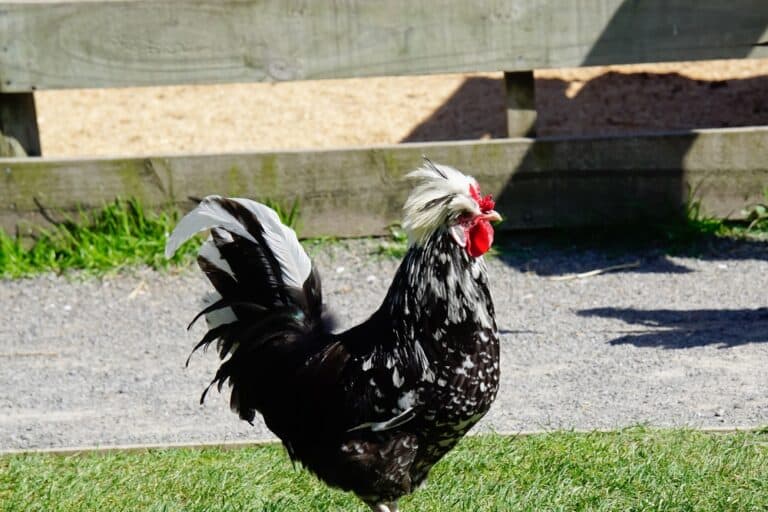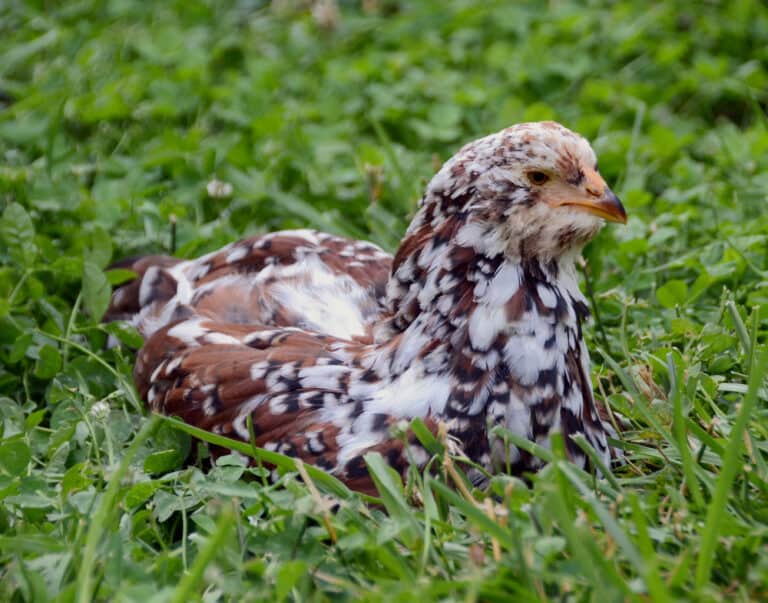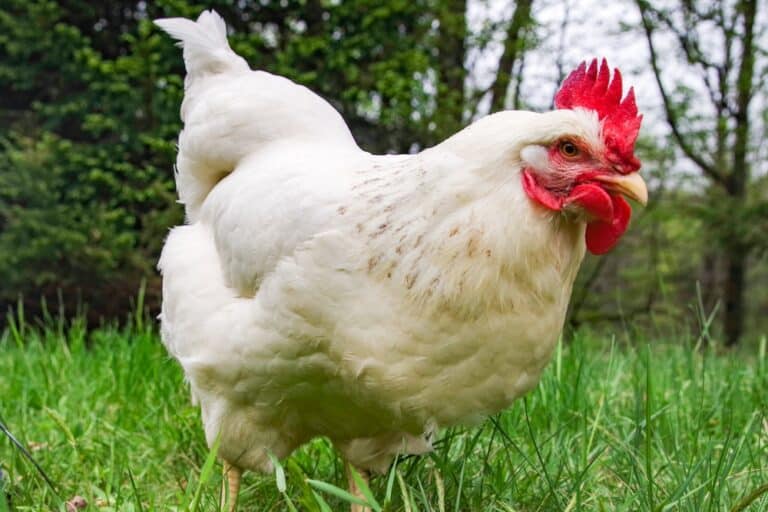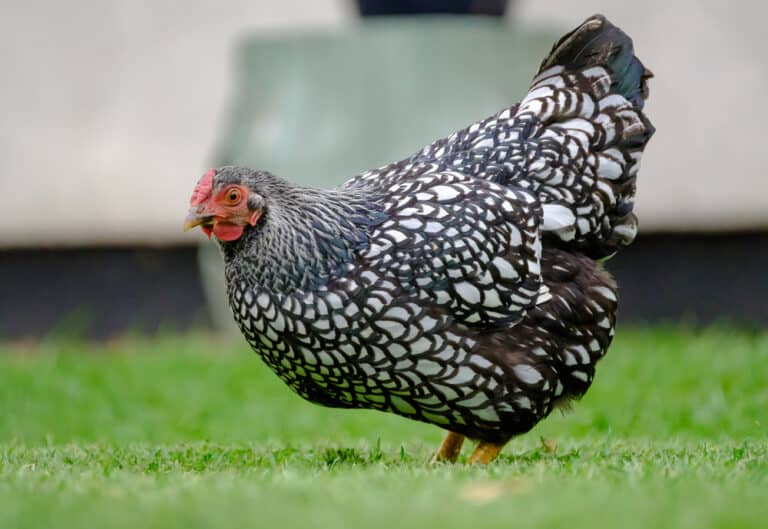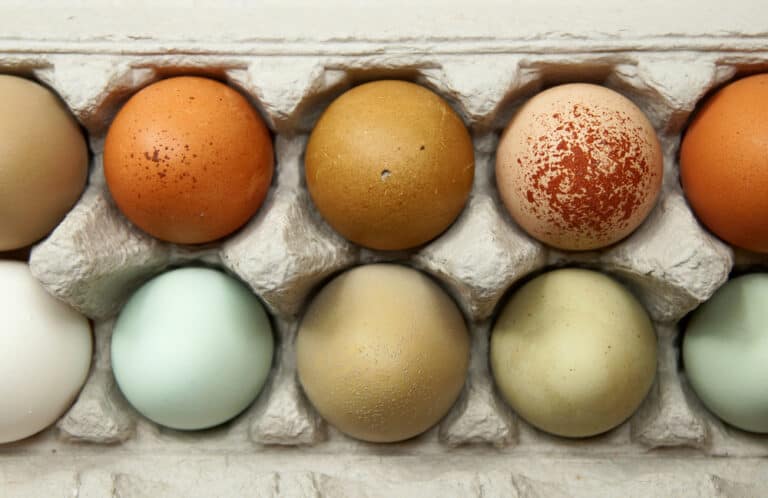Isbar chicken (Silverudd Blue) is a Swedish fowl breed. Hens are well-known for attractive blue/green eggs with purple speckles, while roosters are protectors. Despite their small size, these fighters will stand up to any predator prepared to endanger their flock.
Breeder Martin Silverudd created hardy and docile hens laying eggs throughout the year when kept in adequate conditions, including proper care and nutrition. Besides, these chickens with blue, splash, or black plumage can be lovely pets and supply you with up to five eggs weekly.
Isbar chicken (Silverudd Blue, Swedish Isbar, Svensk Grönvärpare, Blue Isbar, Silverudd Blå, Svensk Gronaggsvarpare) |
|
| Origin | Sweden |
| Breed size | Medium |
| Broodiness | Low with individual exceptions |
| Rarity | Rare |
| Climate tolerance | Excellent cold and high heat tolerance |
| Care level | Easy |
| Lifespan | 5 to 10 years |
| Standard weight | Rooster size – 5.5 to 8 pounds (2.5 – 3.6 kg)Hen size – 3.5 to 6 pounds (1.6 – 2.7 kg) |
| Feather color | Splash, black, and blue |
| Skin color | Yellow |
| Comb type | Single |
| Leg color | Yellow |
| Leg type | Clean |
| Purpose | Egg laying |
| Egg size | Medium to large, 1.75 to 2.30 ounces (50 – 65 g) |
| Egg color | Green, greenish blue, or moss green |
| Annual egg production | 200 to 230 (up to 5 eggs weekly) |
| Sitter | Typically, poor sitter with exceptions |
| Flying ability | Limited |
| Temperament | Friendly, gentle, lively, active, and docile |
| Beginner friendly | Yes |
| Achieving full size | 20 to 22 weeks |
| Start of egg production | 5 to 7 months |
| Price |
|
Isbar History
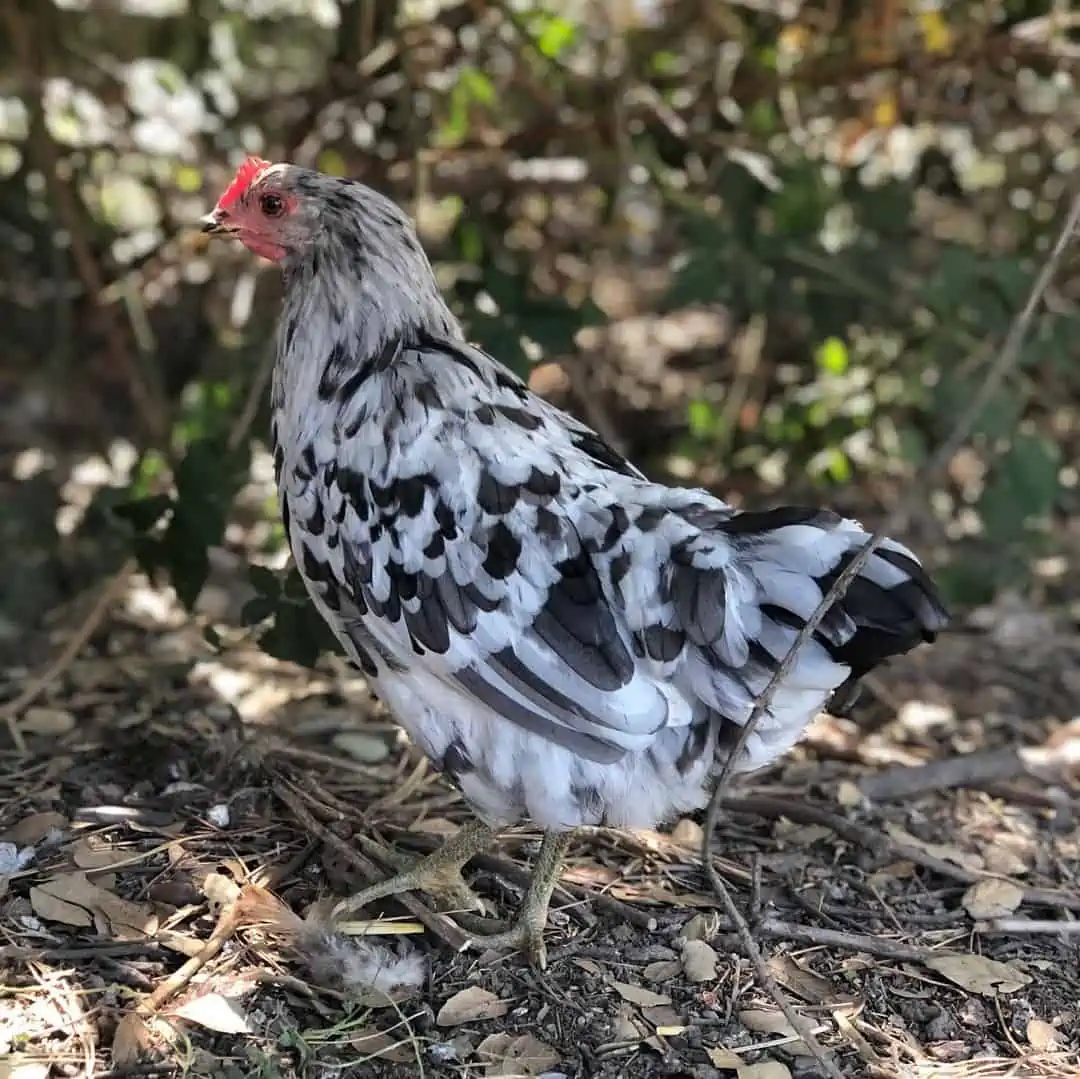
Martin Silverudd from Sweden created a few chicken breeds in the first half of the 20th century. Without modern technology, he managed to breed famous Millefleur-colored 55 Flowery chickens. Then came Smaaland, Molilja, Queen Silvia, and finally Isbar in the 1980s.
Unfortunately, he never finished the breeding process because of the sudden death, so this new breed has remained unstandardized. Many breeders tried to establish these chickens’ characteristics, but Silverudd didn’t leave any note about his goals and desired final traits.
Isbars in Sweden
All existing Isbar chickens are descendants of the leftover fowl from Silverudd’s flock. A few dedicated enthusiasts made a breed profile and saved them but haven’t established the standard traits yet.
It is known that Silverudd combined New Hampshire and Rhode Island Red chickens to get the new breed. Then, he added Cream Legbar for a blue egg trait and Australorps for blue plumage. He aimed to get hardy chickens with low maintenance requirements and excellent egg layer hens producing large and beautiful eggs.
Since 2016, the previous name Isbar was replaced by Silverudd Bla, honoring the breed creator. At the same time, it was a way to prevent confusion with the Isbar blue.
The working name that Silverudd initially used was Swedish Grönegggsvärpare, but it was too complicated for international breeders. Therefore, the new name was a convenient compromise.
Isbars in the US
Greenfire Farms imported the new breed to the US in 2011, where it quickly became popular for its unique appearance and attractive green eggs. Besides, these chickens effortlessly endure a temperature range of -20 F to + 100 F (-29 C to + 37.8 C) and produce eggs all year round.
Unfortunately, demand is more significant than supply, often because of problems breeders have with chickens’ fertility, hatchability, and chicks’ vitality. Only rare were persistent enough to try solving these issues.
Greenfire made the second attempt when importing a new flock in 2013. Unfortunately, that brought undesirable trait diversity and unwelcome qualities. Nowadays, only a dozen American breeders still keep Isbar flocks, trying to save the breed.
Isbar Chicken Traits
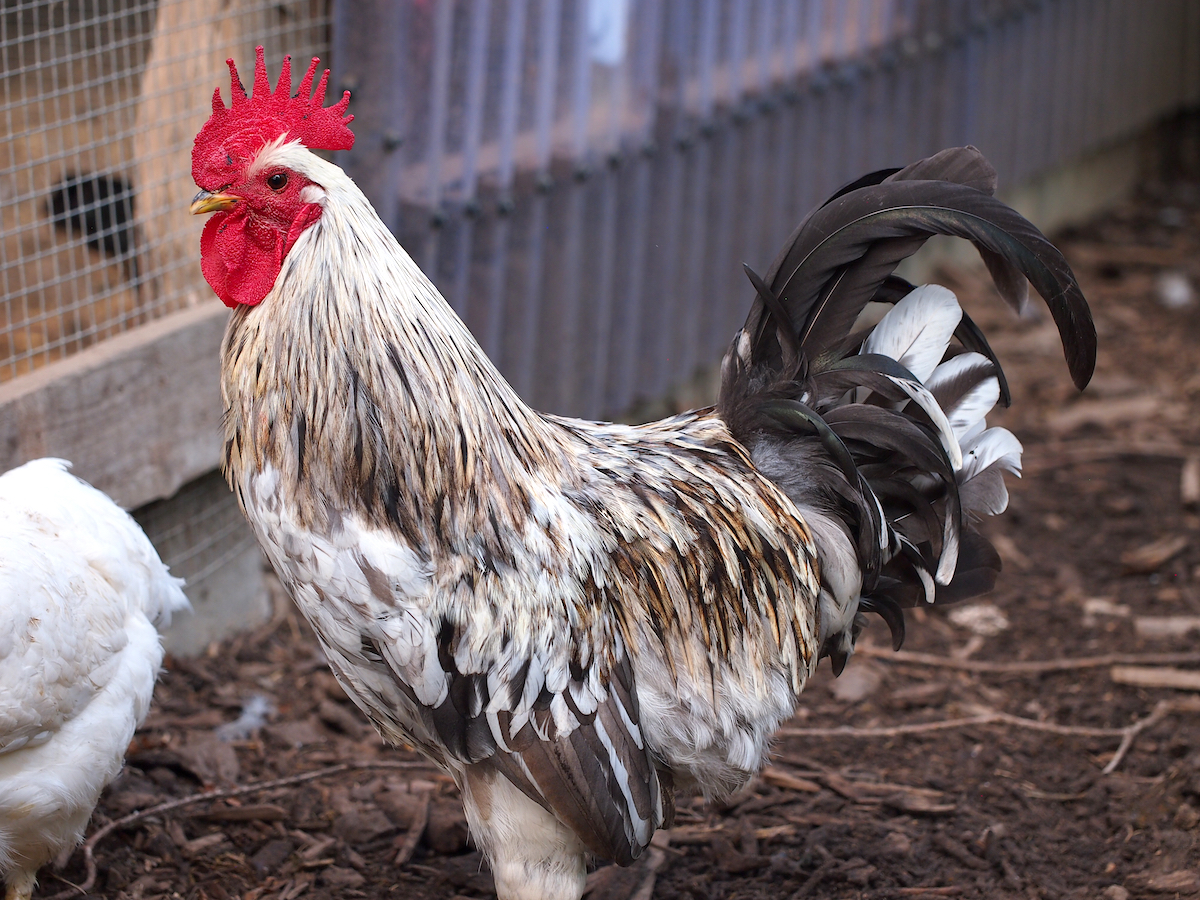
Isbar chickens are a relatively new breed and the only single-comb one worldwide that lays green eggs. Most olive eggers are a cross between hens laying blue and brown eggs.
The first generation is always moss or olive eggers, but it is challenging to maintain a flock with green egg-laying hens. That is why this breed is considered incomplete and not officially standardized yet.
Appearance
Isbar chickens are a medium-sized breed with beautifully colored plumage that shimmer in the sunlight. They have clean yellow legs, red wattles, small earlobes, and single pink or red combs. You can find three types, including:
Black Isbars – Their feathers are black with patches of white on their faces, wings, and chests that disappear after the first molt.
Blue Isbars – Their plumage can be in various blue shades, and you can sometimes get deep indigo or light blue chickens. They occasionally have wings with a unique lace pattern or darker blue heads and necks.
Splash Isbars – Newborn chicks are typically pure or buttery white while splashing (speckles of blue) appear after one to two weeks. Cocks typically have splash bodies with white or blue neck feathering.
Height and weight
Medium-sized Isbar chickens typically weigh 3.5 to 8 pounds (1.6 – 3.6 kg). Roosters are a bit larger, weighing 5.5 to 8 pounds (2.5 – 3.6 kg), with a beautiful red single crest and impressive tail. Hens are elegant, compact, and about 3.5 to 6 pounds (1.6 – 2.7 kg) heavy on average.
Color
You can recognize three Isbar chickens’ color varieties, but be prepared that they rarely breed according to their colors. Depending on the gene combination, their offspring can be lighter, and some chickens are blue or splash.
Isbar chicken breeding chart |
|||
| Parents | Offspring | ||
| Black | Blue | Splash | |
| Black and black | 100% | / | / |
| Black and splash | / | 100% | / |
| Splash and splash | / | / | 100% |
| Black and blue | 50% | 50% | / |
| Blue and splash | / | 50% | 50% |
| Blue and blue | 25% | 50% | 25% |
There are three certainties. Two black or two splash chickens produce chicks of the same color. Likewise, one black and one splash parent always have 100% blue offspring.
In other cases, you can expect surprises. However, you can have an idea of the result in percentage based on parents’ feather colors.
Behavior
Isbar chickens are lovely, docile, adaptable, and friendly creatures, making them calm and sweet companions. They are active, energetic, and lively but never aggressive toward people and love interacting with kids and other birds.
However, roosters are highly protective and alert, keep a close eye on their hens, and immediately react if they are threatened in any way. Besides, they can be suspicious and wary of newcomers, so you should be careful when introducing new birds to the existing flock.
Interestingly, hens take care of the chicks’ upbringing, and you can see them knock them on the head when misbehaving. On the other hand, they are highly protective moms. Some hens can be broody and overprotective, making egg collecting challenging.
Purpose
Isbar hens are prolific egg layers that start laying at 5 to 7 months and produce approximately 200 to 230 annually. However, you can sometimes get even 250 eggs in that period. People like their unusual green color, regardless of whether it is light green, green-blue, or olive shaded.
The most captivating are those with discreet brown speckles. On the other hand, hens inheriting brown egg genes from both parents produce light-tan eggs. By the standard, breeders exclude them from breeding to ensure the breed’s purity.
Even though hens are smaller than standard breeds, their eggs are large. Be prepared that pullets lay smaller eggs that are about 2/3 the size of those from mature hens.
Since this breed tolerates cold weather, many hens keep the production during the winter. Remember that Isbar chickens are not a dual-purpose breed, and their meat is low quality.
Health and Care
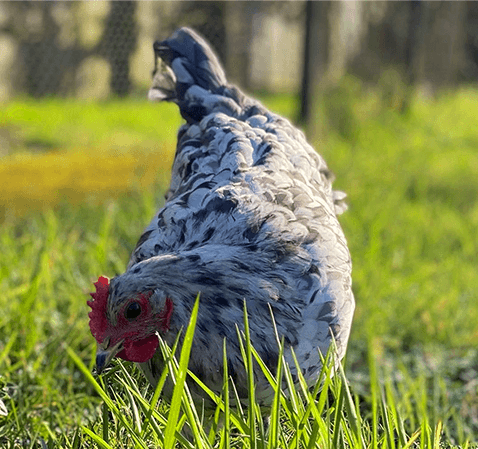
Isbar chickens are a hardy breed that tolerates cold climates excellently but can also thrive in warm regions. They are highly active, so you should provide enough space for their accommodation and roaming.
The coop size depends on the number of chickens you have, but a standard is at least 2 to 3 sq ft (0.19 – 0.28 m2) of floor space per one. Since this breed prefers living freely, you should think about an adequate chicken run on time and provide about 8 to 10 sq ft (0.74 – 0.93 m2) of space per bird.
Expanding that minimal required space is welcome and can significantly improve flock health and reduce stress. The breed genetics and inadequate living conditions often lead to three typical health concerns, including:
- Immunosuppression because of inbreeding
- Chronic respiratory disease in chickens with weak immune system
- Salmonellosis
This breed is well-known as top-shelf foragers, so you should allow them to roam and scrounge up food freely. Like most small-sized and lighter-weight chickens, you can expect Isbars to have low feeding costs.
You should count on approximately $2 to cover the weekly chicks’ cost of feed and electricity. However, the expected price increases as chicks grow.
Summary
Isbar chickens are a medium-sized, relatively quiet breed, and you can use them for egg production and as pets. Their roosters are protectors and fighters prepared to stand up to predators and keep their hens safe. Even though chicks come in three colors, and black is the rarest, the most popular are actually those with blue plumage.

